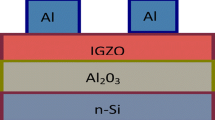Abstract
Amorphous oxide semiconductors (AOSs) exhibiting high mobility in the range of 10–30 cm2/Vs have received significant attention for their application in flexible and transparent electronics such as next-generation displays. Here, we report on how the oxygen volume fraction (vol.%) in the O2/Ar sputter gas affects both the electrical properties of sputtered amorphous In-Zn-O (a-IZO) and the threshold voltage of a-IZO thin film transistor (TFT) devices. As the oxygen fraction increases during sputter deposition, the carrier density in a-IZO is adjusted from the heavily-doped regime of >1020/cm3 to the semiconducting regime of <1017/cm3. A series of bottom-gated TFT devices were fabricated through depositing the channel a-IZO films as a function of O2 vol.%. All the TFTs manufactured operate in depletion mode and the threshold voltage is found to shift positively with the increasing presence of O2 in the sputter gas. These results are attributed to both a decrease in oxygen vacancy defects, which donate two free carriers per vacancy, and a subsequent reduction in the a-IZO channel’s carrier density.
Similar content being viewed by others
References
H. Hosono, M. Yasukawa, and H. Kawazoe, J. Non-Cryst. Solids 203, 334 (1996).
B. Yaglioglu, H.Y. Yeom, R. Beresford, and D.C. Paine, Appl. Phys. Lett. 89, 062103 (2006).
J. Nasrullah, G.L. Tyler, and Y. Nishi, IEEE Trans. Nanotechnol. 4, 303 (2005).
Y.-L. Wang, F. Ren, W. Lim, D.P. Norton, S.J. Pearton, I.I. Kravchenko, and J.M. Zavada, Appl. Phys. Lett. 90, 2321031 (2007).
K. Nomura, A. Takagi, T. Kamiya, H. Ohta, M. Hirano, and H. Hosono, Jpn. J. Appl. Phys. Part 1 Regul. Pap. Brief Commun. Rev. Pap. 45, 4303 (2006).
B.G. Lewis and D.C. Paine, MRS Bull. 25, 22 (2000).
D.C. Paine, T. Whitson, D. Janiac, R. Beresford, C.O. Yang, and B. Lewis, J. Appl. Phys. 85, 8445 (1999).
S. Lee, K. Park, and D.C. Paine, J. Mater. Res. 27, 2299 (2012).
Y.S. Jung, H.Y. Seo, D.W. Lee, and D.Y. Jeon, Thin Solid Films 445, 63 (2003).
B. Yaglioglu, H.Y. Yeom, and D.C. Paine, Appl. Phys. Lett. 86, 261908 (2005).
H.Q. Chiang, D. Hong, C.M. Hung, R.E. Presley, J.F. Wager, C.H. Park, D.A. Keszler, and G.S. Herman, J. Vac. Sci. Technol., B 24, 2702 (2006).
K. Nomura, H. Ohta, A. Takagi, T. Kamiya, M. Hirano, and H. Hosono, Nature 432, 488 (2004).
H. Hosono, J. Non-Cryst. Solids 352, 851 (2006).
E. Chong, K.C. Jo, and S.Y. Lee, Appl. Phys. Lett. 96, 152102 (2010).
E. Chong, S.H. Kim, and S.Y. Lee, Appl. Phys. Lett. 97, 252112 (2010).
S. Lee, H. Park, and D.C. Paine, J. Appl. Phys. 109, 063702 (2011).
S. Lee, B. Bierig, and D.C. Paine, Thin Solid Films 520, 3764 (2012).
D.C. Paine, B. Yaglioglu, Z. Beiley, and S. Lee, Thin Solid Films 516, 5894 (2008).
B.G. Streetman and S.K. Banerjee, Solid State Electronic Devices, 6th ed. (Upper Saddle River: Pearson Prentice Hall, 2006).
S. Lee and D.C. Paine, Appl. Phys. Lett. 102, 052101 (2013).
A.J. Leenheer, J.D. Perkins, M.F.A.M. van Hest, J.J. Berry, R.P. O’Hayre, and D.S. Ginley, Phys. Rev. B 77, 115215 (2008).
N. Ito, Y. Sato, P.K. Song, A. Kaijio, K. Inoue, and Y. Shigesato, Thin Solid Films 496, 99 (2006).
T. Kamiya, K. Nomura, and H. Hosono, Sci. Technol. Adv. Mater. 11, 044305 (2010).
J.-S. Park, H. Kim, and I.-D. Kim, J. Electroceram. 32, 117 (2014).
Y. Taur and T.H. Ning, Fundamentals of Modern VLSI Devices (Cambridge: Cambridge University Press, 2009).
Acknowledgements
This work was supported by the Baylor faculty start-up funds. DCP acknowledges the financial support of the National Science Foundation (NSF) Award No. DMR-1409590. The authors also gratefully thank K-LAB, Korea for the technical support provided.
Author information
Authors and Affiliations
Corresponding author
Rights and permissions
About this article
Cite this article
Reed, A.S., Paine, D.C. & Lee, S. Effect of O2 Fraction in the Sputter Gas on the Electrical Properties of Amorphous In-Zn-O and the Thin Film Transistor Performance. J. Electron. Mater. 45, 6310–6316 (2016). https://doi.org/10.1007/s11664-016-5008-1
Received:
Accepted:
Published:
Issue Date:
DOI: https://doi.org/10.1007/s11664-016-5008-1




